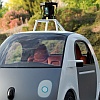
Looking Ahead: Planning for the Arrival of Self-Driving Cars
filed under:
Fully self-driving cars, or “automated vehicles” (AVs) may be seen on the roads of our region in the next ten years or even sooner. Meanwhile, local governments are making long-range transportation plans with time horizons out to the year 2040 and beyond. How are decisionmakers supposed to plan for this technology when so little is known about what it will look like or how people will react to its introduction?
To begin answering questions about AVs, we used our new regional activity-based travel model to test the potential effects of self-driving cars on the local transportation network and on people’s travel choices. PSRC staff presented preliminary results at the Automated Vehicle Symposium in Burlingame, CA, in July 2014, and we submitted the methodology and modeling results for consideration at the upcoming Transportation Research Board (TRB) annual meeting in January 2015.
Methodology
We built four scenarios which captured different levels of market penetration and technological development. At the low end, the first scenario assumed a modest increase in roadway capacity (30%) due to better car-following capabilities. Scenarios two and three captured further market acceptance and full automation, by lowering the in-vehicle time coefficients (to capture people’s ability to multitask or just relax instead of actively driving). Finally, the fourth scenario used a different approach where per-mile usage fees were levied to perhaps mitigate the effects of easier, more ubiquitous access to driving.
Clearly, these are just proxies for possible future behaviors, as our existing models are not designed with this type of technology in mind.
Findings
Again, these results are highly speculative, since no one really knows what the technology or business model surrounding these vehicles will look like yet.
Results show that potential improvements in roadway utilization (due to car-following technology) and improvements in the quality of the driving trip may together lead to increases in total vehicle-miles traveled. Conversely, a possible shift to per-mile usage charges may counteract that trend: imagine a service similar to Uber or Lyft with a per-mile fee, for automated trips in “robotic chauffeur” vehicles.
 |
The exercise also strongly highlighted the need for radically improved travel models in order to better anticipate the arrival of this technology—especially with regard to shared-ride, taxi modes, and the effects of multitasking opportunities.
We’ll have a lot more to say on this topic including more specifics on the methodology and impacts once the TRB paper review process is completed this fall.

